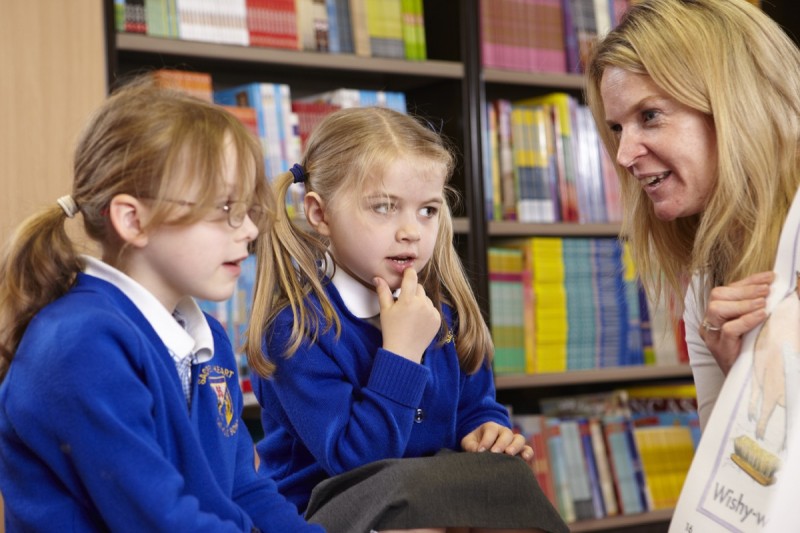For help, advice and telephone ordering call our team on 0121 666 6646
Are you sure you wish to delete this basket?()
This action cannot be undone.
Sorry, something went wrong
Please report the problem here.
Bringing stories to life: the importance of storytelling

May 4th 2021
Picture this: a classroom full of children sitting cross-legged on the floor giggling, laughing and shouting in unison each of the characteristics of a “Gruffalo”, while the teacher at the front shifts from accent to accent as Fox, Snake and Owl encounter that famous purple-prickle-backed creature. It brings a smile to your lips doesn’t it?
A good story will inspire, stimulate and encourage imagination. Reading aloud on a regular basis helps develop language and listening skills. Which is exactly what teachers and educators tell us they want to do… not only to educate our children but to inspire and engage them too.
Peters' curriculum specialists highlight some of the key benefits of reading aloud and storytelling either in class or at home. There are also some tips about what to read and how to add an extra level of interest and bring your stories to life.
Why is it important to read aloud to children?
First and foremost, it’s fun. Which means that learning becomes fun and engaging. Reading aloud enables us to bond with our children/pupils. It connects us and enables us to interact, regardless of age. From nursery to adulthood, shared stories give us a common ground and inspire conversation. The links between children being engaged with literacy and reading for pleasure and their overall attainment and wellbeing are well documented. Schools can help children to love reading by generating enthusiasm through regular story time sessions.
“Reading aloud, for fun, makes children want to read” - Farshore’s recent qualitative research has shown that shared reading very effectively changes attitudes and behaviours: children become motivated to read for fun. Quantitative data shows this clearly, too: those children who are read to ‘daily or nearly every day’ are much more likely to choose to read themselves.*
Class reading is perfect for facilitating purposeful discussion, getting children involved and for bringing up more difficult subjects in a relatable way, that enables children to express their thoughts and feelings.
Storytelling engages and inspires
By reading aloud you can bring a story to life and fire up the imagination of those listening. When you think about it, it’s pretty magical what storytelling can do.
It can help entice even the most reluctant readers or those who struggle to read themselves. Encouraging an element of performance and participation which will in turn, hopefully, create enthusiasm for reading other texts.
When you can engage children like this, you’ll find that the stories you tell them will provide stimulus for their own writing and storytelling. They’ll create characters that resonate with them, live out their dreams and will often bring elements of their own lives into their stories… “the girl with the blue bows in her hair”, “the teacher who never gets cross”, the grandpops who always falls asleep and snores really loudly”, and so on.
Both stories and reading aloud can support, consolidate and facilitate curriculum learning
In EYFS reading aloud teaches children about how words work together to form sentences. It demonstrates to children how to use expression and intonation and improves listening skills.
Reading aloud is also useful for supporting teaching and demonstrating features of language that children may be learning about as part of the curriculum. Grammatical rules and sentence structure are far easier to learn when practiced and read or heard in context. It’s also a great way to expand vocabulary. A teacher reading aloud in class is likely to be reading above the children’s current reading level, meaning they are exposed to words they wouldn’t be able to read themselves and words they won’t typically encounter. When this is the case, it also provides the opportunity to question children and check their comprehension of vocabulary and the story.
Another great benefit to reading aloud is that it supports EAL children to learn the language quickly, as they hear the language in a dynamic and entertaining way, making it easier for them to assimilate.
“Storytelling is the oldest form of teaching. I remember this from my own school experience before the days of computers and technology. Some people believe that storytelling was the reason language developed in the first place, as our minds begin to inquire, wonder and think.
“My favourite experience of storytelling as a teacher was interactive, where the children participated and acted out parts. This was usually repeating specific dialogue or contributing by creating sound effects. It’s important to bring stories to life, so that the audience is totally absorbed and involved.”
Zeena Ark, Peters Curriculum Specialist.
Tips for reading aloud to children
Below are some handy tips to add to your repertoire when reading aloud…
Plan and prepare
- Make sure you’ve read the book in advance so you can decide how to ‘perform’ it
- Choose a book that you love – the children will pick up on your enthusiasm
- Keep track of the books in your school library and familiarise yourself with them so that you can easily choose an appropriate story. (If you have certain topics planned for the year, why not speak to one of our librarians or curriculum specialists who will be able to offer advice and help you with selection.)
- Select a story that you think will resonate with your class, or relates to them in some way
- Gather props - these are great for sound effects, or you could choose a puppet to ‘narrate’ the story
- Figure out if you’re going to stand or sit, and how you’re going to show pictures if it’s a story book
Perform and encourage participation
- Use different voices or accents to bring characters to life
- Use sound effects
- Stand up… move around, creep around on tip toes like Hefty Hugh and Lanky Len and add actions
- This works particularly well with stories that include repetition. Think “Hee Haw” from The Wonky Donkey
Books to read aloud
Anything can be read aloud. It's not what you read, it's how you read it that determines whether it's effective or not. Silly or funny books are always good to share at all ages, as are books with sound effects, rhyme or repetition that children can join in with. (Peace at Last, Bear Hunt, the Oi series, Jack and the Flum Flum Tree, etc.)
For older children choose chapter books that will leave them on a cliff-hanger and wanting more. (Harry Potter or anything by Roald Dahl are usually popular choices, especially for reluctant readers, however there are plenty of suggestions in the list mentioned below.) It’s also a good opportunity for all primary school classes to read something above their reading level that ties in with a current event or specific topic. Poetry is also good for reading aloud, especially if it has a particular rhyme or pattern to it.
We have a list of 100 recommended storytelling texts for primary school pupils, but if you’re short on time, why not consider these....
The Tiger Who Came to Tea by Judith Kerr
We’re Going on A Bear Hunt by Michael Rosen
Why The Whales Came by Michael Morpurgo
Fantastic Mr Fox by Roald Dahl
Mr Stink by David Walliams
If you’d like more help with book selections for your class or school then take a look at our website, there are multiple filter options and settings which enable you to create a library of books that suits your requirements and will align with your lesson planning. Alternatively, get in touch with one of our experts! Our librarians and curriculum specialists are on hand to advise and guide you as part of our bespoke selections service.
National Share-a-Story Month (NSSM) is an annual celebration of the power of storytelling and story sharing, providing a fantastic opportunity to fulfil the core aim of the FCBG of bringing children and stories together. Across the country Federation book groups and individuals run a whole host of events. Each year we are inspired by a specific theme and work with different organisations to provide people with resources and opportunities. National Share-a-Story Month 2021 has the theme of Myths, Magic and Mayhem. Find out more.
*Extract taken from Farshore’s Research Paper - Learnings-From-Lockdown-18th-March-2021.pdf




